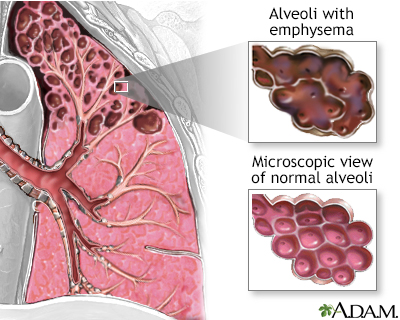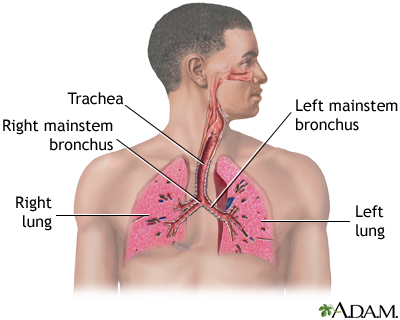Chronic obstructive pulmonary disease (COPD)
Chronic obstructive pulmonary disease (COPD) is a common lung disease. Having COPD makes it hard to breathe.
There are two main forms of COPD:
- Chronic bronchitis, which involves a long-term cough with mucus
- Emphysema, which involves damage to the lungs over time
Most people with COPD have a combination of both conditions.
Causes
Smoking is the main cause of COPD. The more a person smokes, the more likely that person will develop COPD. But some people smoke for years and never get COPD.
Smoking
An in-depth report on the health risks of smoking and how to quit.

If a person has a rare condition in which they lack a protein called alpha-1 antitrypsin, they can develop emphysema even without smoking.

Emphysema
Emphysema is a lung disease involving damage to the air sacs (alveoli). There is progressive destruction of alveoli and the surrounding tissue that supports the alveoli. With more advanced disease, large air cysts develop where normal lung tissue used to be. Air is trapped in the lungs due to lack of supportive tissue which decreases oxygenation.
Other risk factors for COPD are:
- Exposure to certain gases or fumes in the workplace
- Exposure to heavy amounts of secondhand smoke and pollution
- Frequent use of a cooking fire without proper ventilation
Symptoms
Symptoms may include any of the following:
- Cough, with or without mucus
Cough
Coughing is an important way to keep your throat and airways clear. But too much coughing may mean you have a disease or disorder. Some coughs are d...
 ImageRead Article Now Book Mark Article
ImageRead Article Now Book Mark Article - Fatigue
Fatigue
Fatigue is a feeling of weariness, tiredness, or lack of energy.
 ImageRead Article Now Book Mark Article
ImageRead Article Now Book Mark Article - Frequent respiratory infections
- Shortness of breath (dyspnea) that gets worse with mild activity
Dyspnea
Breathing difficulty may involve:Difficult breathing Uncomfortable breathingFeeling like you are not getting enough air
 ImageRead Article Now Book Mark Article
ImageRead Article Now Book Mark Article - Trouble catching one's breath
- Wheezing
Wheezing
Wheezing is a high-pitched whistling sound during breathing. It occurs when air moves through narrowed breathing tubes in the lungs.
 ImageRead Article Now Book Mark Article
ImageRead Article Now Book Mark Article
Because the symptoms develop slowly, many people may not know that they have COPD.
Exams and Tests
The typical test for COPD is a lung function test called spirometry. This involves blowing out as hard as possible into a small machine that tests air movement and lung capacity. The results can be checked right away.
Spirometry
Pulmonary function tests are a group of tests that measure breathing and how well the lungs are functioning.


Spirometry
Spirometry is a painless study of air volume and flow rate within the lungs. Spirometry is frequently used to evaluate lung function in people with obstructive or restrictive lung diseases such as asthma or cystic fibrosis.
Using a stethoscope to listen to the lungs can also be helpful, showing prolonged expiratory time or wheezing. But sometimes, the lungs sound normal, even when a person has COPD.
Imaging tests of the lungs, such as x-rays and CT scans may be ordered. With an x-ray, the lungs may look normal, even when a person has COPD. A CT scan will almost always show signs of COPD if it is present.
x-rays
A chest x-ray is an x-ray of the chest, lungs, heart, large arteries, ribs, and diaphragm.

CT scans
A chest CT (computed tomography) scan is an imaging method that uses x-rays to create cross-sectional pictures of the chest and upper abdomen....

Sometimes, a blood test called arterial blood gas may be done to measure the amounts of oxygen and carbon dioxide in the blood.
Arterial blood gas
Blood gases are a measurement of how much oxygen and carbon dioxide are in your blood. They also determine the acidity (pH) of your blood.

If your health care provider suspects you have alpha-1 antitrypsin deficiency, a blood test will likely be ordered to detect this condition.
Treatment
There is no cure for COPD. But there are many things you can do to relieve symptoms and keep the disease from getting worse.
If you smoke, now is the time to quit. This is the best way to slow lung damage.
Now is the time to quit
Smoking is the leading cause of chronic obstructive pulmonary disease (COPD). Smoking is also a trigger for COPD flare-ups. Smoking damages the air...

Medicines used to treat COPD include:
- Quick-relief medicines to help open the airways
- Control medicines to reduce lung inflammation
- Anti-inflammatory medicines to reduce swelling in the airways
- Certain long-term antibiotics
In severe cases or during flare-ups, you may need to receive:
- Steroids by mouth or through a vein (intravenously)
- Bronchodilators through a nebulizer
- Oxygen therapy
- Assistance from a machine (ventilator) to help breathing by using a mask or through the use of an endotracheal tube
Your provider may prescribe antibiotics during symptom flare-ups, because an infection can make COPD worse.
Flare-ups
Chronic obstructive pulmonary disease (COPD) symptoms can worsen rapidly. You may find it hard to breathe. You may cough or wheeze more or produce ...
Read Article Now Book Mark ArticleYou may need oxygen therapy at home if you have a low level of oxygen in your blood.
Pulmonary rehabilitation does not cure COPD. But it can teach you more about the disease, train you to breathe in a different way so you can stay active and feel better, and keep you functioning at the highest level possible.
LIVING WITH COPD
You can do things every day to keep COPD from getting worse, protect your lungs, and stay healthy.
Can do things every day
Your health care provider gave you the news: you have chronic obstructive pulmonary disease (COPD). There is no cure, but there are things you can d...

Walk to build up strength:
- Ask your provider or respiratory therapist how far to walk.
- Slowly increase how far you walk.
- Avoid talking if you get short of breath when you walk.
- Use pursed lip breathing when you breathe out, to empty your lungs before the next breath.
Things you can do to make it easier for yourself around the home include:
- Avoid very cold air or very hot weather
- Make sure no one smokes in your home
- Reduce air pollution by not using the fireplace and getting rid of other irritants
- Manage stress and your mood
Manage stress and your mood
People with chronic obstructive pulmonary disease (COPD) have a greater risk for depression, stress, and anxiety. Being stressed or depressed can ma...
 ImageRead Article Now Book Mark Article
ImageRead Article Now Book Mark Article - Use oxygen if prescribed for you
Eat healthy foods, including fish, poultry, and lean meat, as well as fruits and vegetables. If it is hard to keep your weight up, talk to a provider or dietitian about eating foods with more calories, by eating small frequent meals.
Surgery or other interventions may be used to treat COPD. Only a few people benefit from these surgical treatments:
- One-way valves can be inserted with a bronchoscopy to help deflate parts of the lung that are hyperinflated (overinflated) in select people.
- Surgery to remove parts of the diseased lung, which can help less-diseased parts work better in some people with emphysema (lung volume reduction surgery).
- Lung transplant for a small number of very severe cases.
Lung transplant
Lung transplant is surgery to replace one or both diseased lungs with healthy lungs from a human donor.
 ImageRead Article Now Book Mark Article
ImageRead Article Now Book Mark Article
Support Groups
You can ease the stress of illness by joining a support group. Sharing with others who have common experiences and problems can help you not feel alone.
Outlook (Prognosis)
COPD is a long-term (chronic) illness. The disease will get worse more quickly if you do not stop smoking.
If you have severe COPD, you will be short of breath with most activities. You may be admitted to the hospital more often.
Talk with your provider about breathing machines and end-of-life care as the disease progresses.
Possible Complications
With COPD, you may have other health problems such as:
Other health problems
If you have chronic obstructive pulmonary disease (COPD), you are more likely to have other health problems, too. These are called comorbidities. P...

- Irregular heartbeat (arrhythmia)
Arrhythmia
An arrhythmia is a disorder of the heart rate (pulse) or heart rhythm. The heart can beat too fast (tachycardia), too slow (bradycardia), or irregul...
 ImageRead Article Now Book Mark Article
ImageRead Article Now Book Mark Article - Need for breathing machine support with a mask (non-invasive ventilation) and oxygen therapy
- Right-sided heart failure or cor pulmonale (heart swelling and heart failure due to chronic lung disease)
Heart failure
Heart failure is a condition in which the heart is no longer able to pump oxygen-rich blood to the rest of the body efficiently. This causes symptom...
 ImageRead Article Now Book Mark Article
ImageRead Article Now Book Mark Article - Pneumonia
Pneumonia
Pneumonia is inflamed or swollen lung tissue due to infection with a germ. This article covers community-acquired pneumonia (CAP). This type of pneu...
 ImageRead Article Now Book Mark Article
ImageRead Article Now Book Mark Article - Collapsed lung (pneumothorax)
- Severe weight loss and malnutrition
- Thinning of the bones (osteoporosis)
Osteoporosis
Osteoporosis is a disease in which bones become fragile and more likely to break (fracture).
 ImageRead Article Now Book Mark Article
ImageRead Article Now Book Mark Article - Debilitation
- Increased anxiety
When to Contact a Medical Professional
Go to the emergency room or call 911 or the local emergency number if you have a rapid increase in shortness of breath.
Prevention
Not smoking prevents most cases of COPD. Ask your provider about quit-smoking programs. Medicines are also available to help you stop smoking.
Quit-smoking
Smoking is the leading cause of chronic obstructive pulmonary disease (COPD). Smoking is also a trigger for COPD flare-ups. Smoking damages the air...

Talk to your provider about getting the flu, pneumonia (pneumococcal), COVID-19, and other vaccines.
Reviewed By
Allen J. Blaivas, DO, Division of Pulmonary, Critical Care, and Sleep Medicine, VA New Jersey Health Care System, Clinical Assistant Professor, Rutgers New Jersey Medical School, East Orange, NJ. Review provided by VeriMed Healthcare Network. Also reviewed by David C. Dugdale, MD, Medical Director, Brenda Conaway, Editorial Director, and the A.D.A.M. Editorial team.
Global Initiative for Chronic Obstructive Lung Disease (GOLD) website. 2024 GOLD report. Global strategy for prevention, diagnosis and management of COPD: 2024 report. goldcopd.org/2024-gold-report/. Accessed April 29, 2025.
Han MK, Lazarus SC. COPD: diagnosis and management. In: Broaddus VC, Ernst JD, King TE, et al, eds. Murray & Nadel's Textbook of Respiratory Medicine. 7th ed. Philadelphia, PA: Elsevier; 2022:chap 64.
National Institutes of Health, National Heart, Lung, and Blood Institute website. COPD national action plan. www.nhlbi.nih.gov/health-topics/education-and-awareness/COPD-national-action-plan. Updated February 9, 2021. Accessed April 29, 2025.
Reilly J. Chronic obstructive pulmonary disease. In: Goldman L, Cooney KA, eds. Goldman-Cecil Medicine. 27th ed. Philadelphia, PA: Elsevier; 2024:chap 76.
Rochester CL, Nici L. Pulmonary rehabilitation. In: Broaddus VC, Ernst JD, King TE, et al, eds. Murray & Nadel's Textbook of Respiratory Medicine. 7th ed. Philadelphia, PA: Elsevier; 2022:chap 139.







